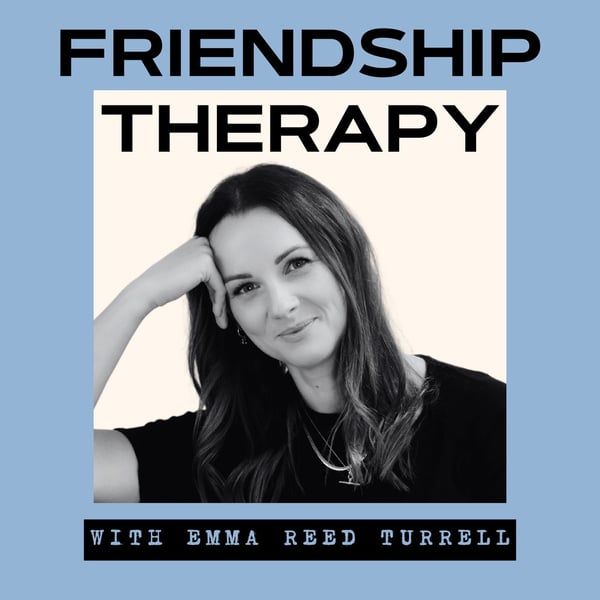S1, Ep 4 BITESIZE Friendship Therapy: The Nursing Triad - friends as co-parents
Friendship Therapy
Emma Reed Turrell
4.8 • 1.2K Ratings
🗓️ 14 June 2024
⏱️ 22 minutes
🧾️ Download transcript
Summary
This week, Emma met another Emma, a psychotherapist who found herself questioning her place in her childhood friendship group after becoming a mother at 19, going through a divorce in her thirties and persuing a new career as a therapist later in life.
In this bitesize episode, Emma takes us through the Nursing Triad, healthy first order symbiosis and Eric Berne's Parent, Adult Child ego states theory within Transactional Analysis, and how Emma's friends played a practical and emotional co-parent role in Emma's life as she navigated becoming a mother when she was still a child herself.
Emma also reflects on Emma's therapy journey, her growing curiosity and defiance against decades-old patterns, and how she found herself challenging the boundaries and renegotiating her friendships to find out if she could be accepted unconditionally.
To find out more about Eric Berne's Parent, Adult, Child theory, click here: https://www.simplypsychology.org/transactional-analysis-eric-berne.html
If you’d like to apply to appear on the podcast in season two, please click the link below to fill out the form:
https://forms.gle/owsfs6DVxVdTMFo46
---
Friendship Therapy is hosted by Emma Reed Turrell, produced by Chris Sharp and Lauren Brook.
---
Social media:
Emma Reed Turrell @emmareedturrell
Friendship Therapy @friendshiptherapypod
Email: [email protected]
Transcript
Click on a timestamp to play from that location
| 0:00.0 | This Podcast is sponsored by Protein Works, creators of award-winning tasty food, shakes and snacks. |
| 0:07.0 | Welcome back to another episode of Friendship Therapy Bitesize, The Bit Where we do some of those therapy takeaways from the episode that we heard earlier in the week and this week we were joined by the lovely Emma, great name. |
| 0:24.0 | And she is a therapist, a practicing therapist, |
| 0:27.4 | which means we had a really interesting conversation |
| 0:29.9 | all about life and friendships before she started therapy because part of the journey to |
| 0:35.9 | becoming a therapist is having therapy yourself and life and friendships afterwards and |
| 0:40.9 | what they look like and how they differ. I want to look at the |
| 0:47.4 | takeaways today in kind of three sections so first of all we're going to look at something that's a piece of theory that you can look up if you want to. It's called a nursing triad. The reason I want to bring this up and you know that I come from a |
| 1:03.6 | transactional analysis point of view is because Emma's story is such a great |
| 1:08.8 | example of what we would call a kind of healthy first-order symbiosis. |
| 1:15.0 | I know that sounds really technical, but just bear with me. |
| 1:18.0 | What she was telling us about was how she became a mom. |
| 1:22.0 | She became a mom at 19 and her friendships were really part of her support |
| 1:29.2 | part of her scaffoldingolding. They emotionally were there for her. They were there for her practically. She said it herself, they were there to give her a kick-up-the-ar sometimes, if that's what they felt she needed. All of this support was so essential for this |
| 1:47.6 | 19 year old who was parenting herself at this point and had a lot of responsibility as well as a lot of needs herself. |
| 1:56.0 | So in the nursing triad, what we see and these are diagrams that were created in the 70s and there are certain normative elements that aren't |
| 2:09.2 | necessarily helpful or relevant today but what effectively that diagram shows is a very |
| 2:15.0 | traditional model of a parent supporting the other parent to support an infant, a baby. |
| 2:24.0 | So if you've followed any of my |
| 2:28.0 | podcast episodes before on transactional analysis, |
| 2:30.0 | you might be already familiar with this idea of parent adult child but here is a |
| 2:34.8 | quick recap which makes me sound like I'm asking Graham from Blind Day anyway come back |
... |
Transcript will be available on the free plan in -292 days. Upgrade to see the full transcript now.
Disclaimer: The podcast and artwork embedded on this page are from Emma Reed Turrell, and are the property of its owner and not affiliated with or endorsed by Tapesearch.
Generated transcripts are the property of Emma Reed Turrell and are distributed freely under the Fair Use doctrine. Transcripts generated by Tapesearch are not guaranteed to be accurate.
Copyright © Tapesearch 2025.

